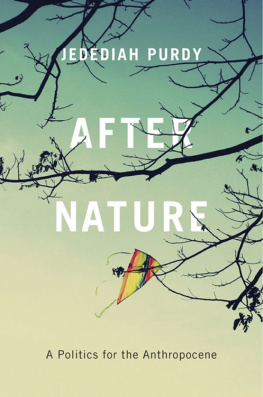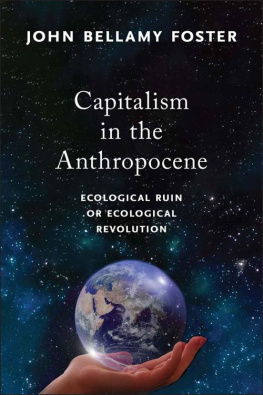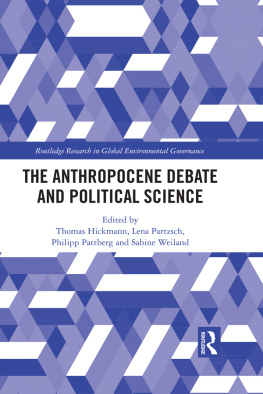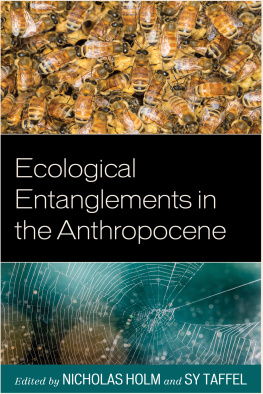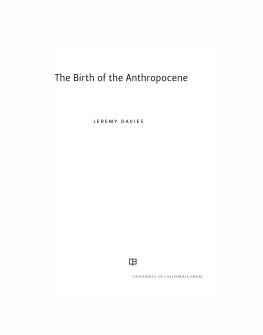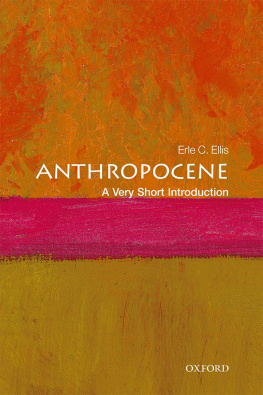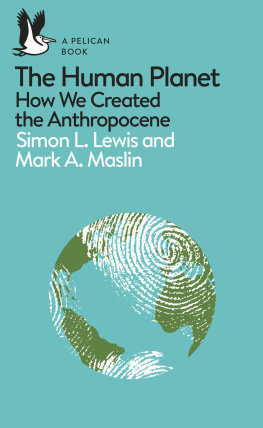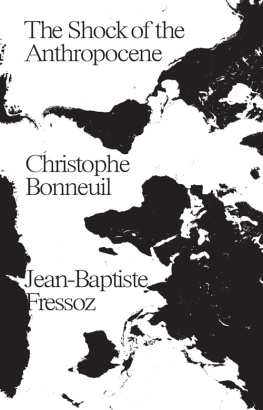AFTER NATURE
AFTER
NATURE
A Politics for the Anthropocene

JEDEDIAH PURDY
HARVARD UNIVERSITY PRESS
CAMBRIDGE, MASSACHUSETTS
LONDON, ENGLAND
2015
Copyright 2015 by Jedediah Purdy
All rights reserved
Jacket art: Getty Images
Jacket design: Graciela Galup
978-0-674-36822-4 (alk. paper)
978-0-674-91569-5 (EPUB)
978-0-674-91568-8 (MOBI)
978-0-674-91567-1 (PDF)
THE LIBRARY OF CONGRESS HAS CATALOGED THE PRINTED EDITION AS FOLLOWS:
Purdy, Jedediah.
After nature : a politics for the anthropocene / Jedediah Purdy.
pages cm
Includes bibliographical references and index.
1. NatureEffect of human beings on. 2. Human beingsEffect of environment on. 3. Human ecology. 4. Philosophical anthropology. I. Title.
GF75.P87 2015
320.580973dc23
2015003588
For everyone who goes walking with me
CONTENTS
OFFICIALLY, FOR THE PAST 11,700 YEARS we have been living in the Holocene epoch. The Holocene, which takes its name from the Greek for totally new, is an eye-blink in geological time. During its nearly 12,000 years, plate tectonics has driven the continents a little more than half a mile: a reasonably fit person could cover the scale of planetary change in a brisk eight-minute walk. It has been a warm time, when temperature has mattered as much as tectonics: sea levels rose 115 feet as ice melted, and northern landscapes rose almost 600 feet, rebounding from the weight of now-melted glaciers. But the real news in the Holocene has been people. Estimates put the global human population between 1 million and 10 million at the start of the Holocene, and keep it in that range until after the agricultural revolution, some 5,000 years ago. Since then, we have made the world our anthill: the geological layers we are now laying down on the earths surface are marked by our chemicals and other industrial emissions, the pollens of our crops, and the absence of the many species we have driven to extinction. Rising sea levels are now our doing. As a driver of global change, humanity has outstripped geology.
This is why more and more voices in a great range of fields, from the earth sciences to English departments, propose that we live in a new era: the Anthropocenethe age of humans. The term was coined by ecologist Eugene Stoermer in the 1980s and has gained prominence since 2000, when Paul Crutzen, a Nobel-winning atmospheric scientist, urged scientists to adopt it. In 2008, the Stratigraphy Commission of the Geological Society of Londonthe people who set and enforce the boundaries of eras, the Pleistocene Policetook up a proposal to add the Anthropocene to the official timeline of earths epochs. (It is still pending: stratigraphers are well acquainted with geological rates of motion.) The proposal suggests that we have entered a new era of the earths history, when humans are a force, maybe the force, shaping the planet.
The scientific debate about geological eras, supposedly rooted in hard facts, ironically reveals that the Anthropocene is not a simple question of fact at all. The classic way to delineate geological eras is via breaks in the fossil record. Its true that the extinctions were causing will change the mix of future fossils; but that doesnt tell us how to define the Anthropocene. The Anthropocene is, in important ways, a slogan for the age of climate change. Some scientists, accordingly, date it to the Industrial Revolution, when the spike in carbon emissions began. Others look back as much as 5,000 years, to a time when methane levels rose sharply, maybe because of rice cultivation in Asiaa way of saying that farming, not factories, marked the great change in the relationship between humans and nature.
To define the Anthropocene is to emphasize what we think is most important in that relationship. We have to know which critical balance has shifted. Saying we live in the Anthropocene is not like saying the earth is 4.5 billion years old rather than 6,000. Its more like saying the United States is a secular country, or a religious one. Its not a statement of fact as much as a way of organizing facts to highlight a certain importance that they carry.
What has changed, then? How is this time different from all times before it? The Anthropocene finds its most radical expression in our acknowledgment that the familiar divide between people and the natural world is no longer useful or accurate. Because we shape everything, from the upper atmosphere to the deep seas, there is no more nature that stands apart from human beings. There is no place or living thing that we havent changed. Our mark is on the cycle of weather and seasons, the global map of bioregions, and the DNA that organizes matter into life. It makes no sense now to honor and preserve a nature that is defined by being not human, that is purest in wilderness, rain forests, and the ocean. Instead, in a world we cant help shaping, the question is what we will shape.
The Anthropocene marks the last of three revolutions. Three kinds of order once thought to be natural and self-sustaining have shown themselves to be artificial, fragile, and potentially self-immolating. The first to fall was politics: long seen as part of divine design, with kings serving as the human equivalents of lions in the desert and eagles in the sky, politics proved instead a dangerous but inescapable form of architecturea blueprint for peaceful coexistence, built with crooked materials. Second came economics: once presented as a gift of providence or an outgrowth of human nature, economic life, like politics, turned out to be a deliberate and artificial achievement, and vulnerable to its own kinds of crises. Now, in the Anthropocene, we have to add nature itself to the list of things that are not natural. In every respect, the world we inhabit will henceforth be the world we have made. This is not reassuring: politics, economics, and ecology are all in near-perpetual crisis.
The revolution in ideas that the Anthropocene representsthe end of the division between people and natureis rooted in hundreds of eminently practical problems. The conversation about climate change has shifted from whether we can keep greenhouse-gas concentrations below key thresholds to how we are going to adapt when they cross those thresholdsand change everything from global weather to the acidity of the oceans. Geo-engineering, deliberate intervention in planetary systems, which used to be the unspeakable proposal, is in the mix of responses and almost sure to grow more prominent. As climate change shifts ecological boundaries, problems like habitat preservation come to resemble landscape architecture. We cant just pen in animals to save them; we need to secure migration corridors and help species move as their habitats lurch across a changing map. There is open talk in law-and-policy circles about triage in species preservationasking what we can save, and what we most want to save. We can call the sum of these changes, the vast and irreversible human impact on the planet, the Anthropocene Condition.
Using the portmanteau term Anthropocene for all these phenomena is willful, an effort to meld them into a single situation, gathered under a single name. In this way, talking about the Anthropocene is an attempt to do what the concept of the environment did in the 1960s and early 1970s: join problems as disparate as extinction, sprawl, litter, national-parks policy, and atomic fallout into a single challenge called the environmental crisis. Such a term is pragmatic: it tries to help people to act by gathering the elements of their predicament together in a tractable way. The environment had to be named before people could join together to try to save it. The Anthropocene has to be named before people can try to take responsibility for it.
Next page
